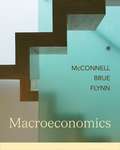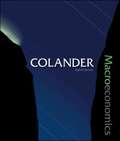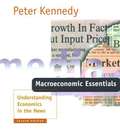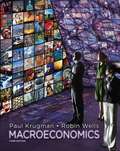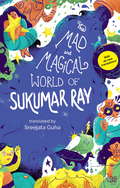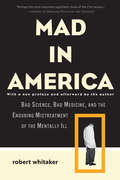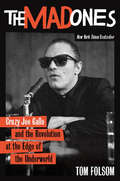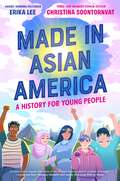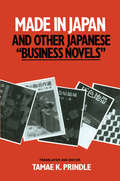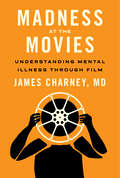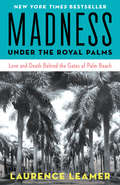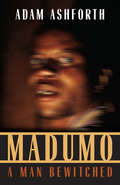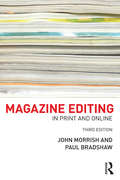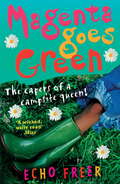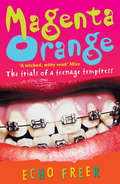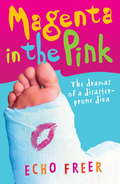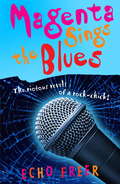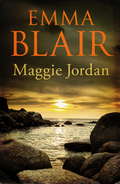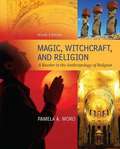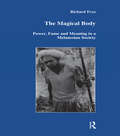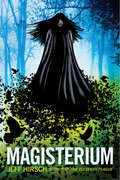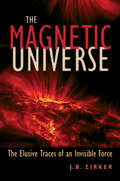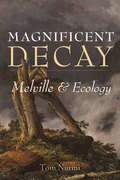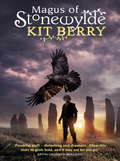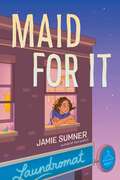- Table View
- List View
Macroeconomics: Principles, Problems, and Policies (18th Edition)
by Campbell R. Mcconnell Stanley L. Brue Sean M. FlynnThis book elaborates on the principles essential for understanding the economizing problem, specific economic issues, and the policy alternatives and helps to apply the economic perspective.
Macroeconomics (8th Edition)
by David C. ColanderWritten in an informal colloquial style, this student-friendly Macroeconomics textbook does not sacrifice intellectual depth in its quest for accessibility. The author's primary concern is to instill "economic sensibility" in the student. Colander emphasizes the intellectual and historical context to which the economic models are applied. Distinguishing features found within Colander's text are: Cutting Edge and Modern Colloquial Style, Narrative Focus on Policy, Emphasis on the Importance of Institutions and History, Focus on Modeling. Economics is a method of reasoning, not truths. Presents Alternative Perspectives in Economics.
Macroeconomics Essentials: Understanding Economics in the News (Second Edition)
by Peter KennedyWhat do we want our students to be able to do upon completing an introductory course in macroeconomics--shift curves on diagrams or interpret media commentary on the economy? This book, an effort to lead students in the latter direction, offers a clear exposition of introductory macroeconomic theory along with more than 600 one- or two-sentence "news clips" that serve as illustrations and exercises. The author calls this approach "media economics" to distinguish it from the encyclopedic character of traditional texts. The book provides a guide to what the author calls the "really important" ideas of macroeconomics, with a strong connection to the real world. Thus many instructors will find the book suitable for use in courses enrolling business students. The method of presentation allows room for topics that are crucial for the interpretation of news commentary, but given inadequate coverage in traditional macroeconomics texts. Examples include the many roles of nominal versus real interest rates, and international phenomena such as purchasing power parity. Despite its nontechnical presentation, the material in the book is quite challenging for students; to answer questions based on the news clips, students must truly understand the economic concepts and apply problem-solving skills rather than rote learning. This text, unlike other economic texts, provides the student with a practical yet sophisticated grasp of the macroeconomic principles necessary to interpret media commentary. The second edition has been revised and updated throughout.
Macroeconomics (Third Edition)
by Paul Krugman Robin WellsWhen it comes to explaining current economic conditions, there is no economist readers trust more than New York Times columnist and Nobel laureate Paul Krugman. Term after term, Krugman is earning that same level of trust in the classroom, with more and more instructors introducing students to the fundamental principles of economics via Krugman's signature storytelling style. The new Third Edition of Paul Krugman and Robin Wells's Economics is their most accomplished yet--extensively updated to offer new examples and stories, new case studies from the business world, and expert coverage of the ongoing financial crisis.
The Mad and Magical World of Sukumar Ray
by Sukumar RayWelcome to the extraordinary world of Sukumar Ray – King of Humour and Wizard of Wordplay!A gifted poet, writer, playwright and illustrator, Ray wrote stories of various shapes, colours and flavours, transforming words into things of wonder and whimsy for generations of readers. Featuring broken stars and enchanted forests, cures for anger and greed, lazy pigs and sly parrots, wicked sorcerers and talking dolls, many of the tales in this unusual medley have been translated into English for the first time. The collection highlights not only Ray’s crazy imagination but also his ability to breathe life into fables from faraway lands. Brimming with wit and magic, this dazzling display of Sukumar Ray’s storytelling genius is sure to leave you utterly spellbound.
Mad in America: Bad Science, Bad Medicine, and the Enduring Mistreatment of the Mentally Ill
by Robert WhitakerSchizophrenics in the United States currently fare worse than patients in the world's poorest countries. In Mad in America, medical journalist Robert Whitaker argues that modern treatments for the severely mentally ill are just old medicine in new bottles, and that we as a society are deeply deluded about their efficacy. The widespread use of lobotomies in the 1920s and 1930s gave way in the 1950s to electroshock and a wave of new drugs. In what is perhaps Whitaker's most damning revelation, Mad in America examines how drug companies in the 1980s and 1990s skewed their studies to prove that new antipsychotic drugs were more effective than the old, while keeping patients in the dark about dangerous side effects. A haunting, deeply compassionate book--now revised with a new introduction--Mad in America raises important questions about our obligations to the mad, the meaning of "insanity," and what we value most about the human mind.
The Mad Ones: Crazy Joe and the Revolution at the Edge of the Underworld
by Tom FolsomA powerful collision of true crime and pop culture, The Mad Ones captures the revolutionary spirit of the sixties and brings to life one of the most vibrant antiheroes in American history.
Made in Asian America: A History for Young People
by Erika Lee Christina SoontornvatFrom three-time Newbery Honoree Christina Soontornvat and award-winning historian Erika Lee comes a middle grade nonfiction that shines a light on the generations of Asian Americans who have transformed the United States and who continue to shape what it means to be American.Asian American history is not made up of one single story. It’s many. And it’s a story that too often goes untold. It begins centuries before America even exists as a nation. It is connected to the histories of Western conquest and colonialism. It’s a story of migration; of people and families crossing the Pacific Ocean in search of escape, opportunity, and new beginnings.It is also the story of race and racism. Of being labeled an immigrant invasion, unfit to become citizens, and being banned, deported, and incarcerated. Of being blamed for bringing diseases into the country.It is also a story of bravery and hope. It is the story of heroes who fought for equality in the courts, on the streets, and in the schools, and who continue to fight in solidarity with others doing the same.This book is a stirring account of the ordinary people and extraordinary acts that made Asian America and the young people who are remaking America today.
Made in Japan and Other Japanese Business Novels
by Tamae K. PrindleThe term "business novel" is a translation of the Japanese word kezai shosetsu, which may be translated literally as * 'economy novel.'' Critic Makoto Sataka first used the word "business" in place of "economy" in his monograph How to Read Business Novels (1980).l Business novels are "popular novels" (taishu bungaku) widely read by Japanese businessmen, their wives, students, and other professionals.. Business novels were recognized as a * 'field'' or a literary sub-genre in the late 1950s. It was Saburo Shiroyama's Export (Yushutsu) (1957), if not his Kinjo the Corporate Bouncer (Sokaiya Kinjo) (1959), which marshalled their enormous popularity. The seven short works in this collection represent prototypes of the business novel. Their distinctive features are that business activities motivate plot developments, although psycho-socio-cultural elements are tightly interwoven.
Madness at the Movies: Understanding Mental Illness through Film
by James CharneyA unique exploration of how mental illness is portrayed in classic and contemporary films.The study of classic and contemporary films can provide a powerful avenue to understand the experience of mental illness. In Madness at the Movies, James Charney, MD, a practicing psychiatrist and long-time cinephile, examines films that delve deeply into characters' inner worlds, and he analyzes moments that help define their particular mental illness. Based on the highly popular course that Charney taught at Yale University and the American University of Rome, Madness at the Movies introduces readers to films that may be new to them and encourages them to view these films in an entirely new way. Through films such as Psycho, Taxi Driver, Through a Glass Darkly, Night of the Hunter, A Woman Under the Influence, Ordinary People, and As Good As It Gets, Charney covers an array of disorders, including psychosis, paranoia, psychopathy, depression, bipolar disorder, obsessive-compulsive disorder, and anxiety. He examines how these films work to convey the essence of each illness. He also looks at how each film reflects the understanding of mental illness at the time it was released as well as the culture that shaped that understanding.Charney explains how to observe the behaviors displayed by characters in the films, paying close attention to signs of mental illness. He demonstrates that learning to read a film can be as absorbing as watching one. By viewing these films through the lens of mental health, readers can hone their observational skills and learn to assess the accuracy of depictions of mental illness in popular media.
Madness Under the Royal Palms: Love and Death Behind the Gates of Palm Beach
by Laurence LeamerLove, lust, and fatal hatreds inside America's most exclusive enclave of wealth and privilege--Palm Beach.Bernard Madoff's Ponzi scheme devastated the eternally sunny world of Palm Beach, bringing down multimillionaires and destroying once-wealthy widows. The South Florida island and its rarified life suddenly found itself at the epicenter of the scandal, with this strange universe of wealth and privilege under an unrelenting spotlight.Now, in Madness Under the Royal Palms, Laurence Leamer shows us--as no one else has--this world of the megawealthy, which he calls "as hidden a place as I have ever resided." Digging deep, he hits a dark well of conflicting ambitions--right up to and including murder--much darker than the sky-blue weather and sunny Lily Pulitzer prints most of us associate with Palm Beach.
Madumo: A Man Bewitched
by Adam AshforthThe author tells a story about his friend, a young man named Madumo, struggling to free himself from the curse of witchcraft in Soweto, South Africa. It is based upon shared experiences and taped conversations, interviews and discussions with others, journals, and letters.
Magazine Editing: In Print and Online
by Paul Bradshaw John MorrishIncluding comprehensive coverage on both print and online, consumer and free magazines, Magazine Editing looks at how magazines work and explains the dual role of the magazine editor. John Morrish and Paul Bradshaw consider the editor both as a journalist, having to provide information and entertainment for readers, and as a manager, expected to lead and supervise successfully the development of a magazine or periodical. Looking at the current state of the magazine market in the twenty-first century, the third edition explains how this has developed and changed in recent years, with specific attention paid to the explosion of apps, e-zines, online communities and magazine websites. Featuring case studies, interviews with successful editors, examples of covers and spreads, and useful tables and graphs, this book discusses the editor’s many roles and details the skills needed to run a publication. Magazine Editing offers practical guidance on: how to create an editorial strategy how to lead and manage an editorial team researching a market and finding new readers dealing with budgets and finance working with designers and production staff legal, technological and ethical dilemmas online distribution, social media and search engine optimisation managing information overload how to become an editor.
Magenta Goes Green
by Echo FreerMagenta's in trouble with Daniel again - this time, for snogging the school new-boy Chad Albright on a charity Blind Date. As if this wasn't bad enough, she's been picked to go on the school outward-bound camp. It's not really her cup of tea - mix Magenta with any physical activities, and here comes disaster ...
Magenta Orange
by Echo FreerCalamity seems to follow Magenta everywhere. Her neighbour, Daniel, tries to help but, inevitably, ends up inveigled into her schemes with hilarious results. Magenta has set her sights on Year 11 heart-throb, Adam Jordan, but all her attempts to impress him are thwarted by a series of mishaps. Adam is convinced she is a jinx and tries to avoid her at all costs - while Daniel spends his time trying to demonstrate his undying affection for Magenta - will the best man win?
Magenta Orange: Magenta in the Pink
by Echo FreerMagenta has finally got it together with her neighbour - and nearest thing to a best friend a boy can be - Daniel. But nothing is ever easy for Magenta - as she prepares to take the starring role in the school play, will the course of true love never run smooth?
Magenta Sings The Blues
by Echo FreerMagenta's best friends are going to be performing in the Battle of the Bands - but they haven't asked her to join! OK, so she's tone deaf, but that shouldn't be a barrier for the truly talented. And Magenta needs to be centre stage to catch the attention of this year's hottest talent, Spyros Evangelides. If only she didn't have two left feet, she could become a disco diva and show ex-boyfriend Daniel what he's missing ...
Maggie Jordan
by Emma BlairWhen most of Maggie Jordan's family are killed in a freak flood in the small coastal village of Heymouth, she is forced to find work in one of Glasgow's carpet mills. She becomes engaged to Nevil Sanderson, who suddenly decides he must go to Spain and join the Republicans in their fight against Franco.Although she struggles on without him, Maggie eventually realises her place is by his side and journeys to Spain to join him. But the newly promoted Nevil has become distant and ruthless, and is fiercely jealous of her new friendship with American journalist Howard Taft.Years later, married and with an eight-year-old daughter, Maggie has returned to Glasgow. Astonished when Howard reappears, bringing light and laughter back into her life, she is forced to take decisions - decisions which threaten to destroy even the vibrant and courageous Maggie Jordan.Praise for Emma Blair:'An engaging novel and the characters are endearing - a good holiday read' Historical Novels Review'All the tragedy and passion you could hope for . . . Brilliant' The Bookseller'Romantic fiction pure and simple and the best sort - direct, warm and hugely readable. Women's fiction at an excellent level' Publishing News'Emma Blair explores the complex and difficult nature of human emotions in this passionately written novel' Edinburgh Evening News'Entertaining romantic fiction' Historical Novels Review'[Emma Blair] is well worth recommending' The Bookseller
Magic, Witchcraft, and Religion: A Reader in the Anthropology of Religion, Ninth Edition
by Pamela MoroMagic Witchcraft and Religion: A Reader in the Anthropology of Religion takes an anthropological approach to the study of religious beliefs and practices, both strange and familiar. The engaging articles on all key issues related to the anthropology of religion grab the attention of students, while giving them an excellent foundation in contemporary ideas and approaches in the field. The multiple authors included in each chapter represent a range of interests, geographic foci, and ways of looking at each subject. Features of the ninth edition include new study questions and articles, as well as updated discussions on religion, illness, healing, and death.
The Magical Body: Power, Fame and Meaning in a Melanesian Society
by Richard EvesAn intriguing exploration of the role and significance of the body in the world of a Pacific Islands People, the Lelet of New Ireland (Papua New Guinea). In vivid ethnographic detail, the monograph captures the fluidity and complexity of Lelet conceptions of corporeality and their significance to identity as they encounter the influences of modernity, in the form of colonialism, Christianity and cash-cropping. The author examines the importance of the body to constructions of identity and difference, and its role in the constitution of place and space. The book provides a richly detailed ethnographic study of magical belief and the body whilst paying particular attention to the polyvalent meanings of bodily images and metaphors as they are used in numerous contexts of magic.
Magisterium
by Jeff HirschOn one side of the Rift is a technological paradise without famine or want. On the other side is a mystery.Sixteen-year-old Glenn Morgan has lived next to the Rift her entire life and has no idea of what might be on the other side of it. Glenn's only friend, Kevin, insists the fence holds back a world of monsters and witchcraft, but magic isn't for Glenn. She has enough problems with reality: Glenn's mother disappeared when she was six, and soon after, she lost her scientist father to his all-consuming work on the mysterious Project. Glenn buries herself in her studies and dreams about the day she can escape. But when her father's work leads to his arrest, he gives Glenn a simple metal bracelet that will send Glenn and Kevin on the run---with only one place to go.With MAGISTERIUM, Jeff Hirsch brings us the story of a complex, captivating world that will leave readers breathless until the very last page.
The Magnetic Universe: The Elusive Traces of an Invisible Force
by J. B. ZirkerA main selection of Scientific American Book ClubMagnetic fields permeate our vast universe, urging electrically charged particles on their courses, powering solar and stellar flares, and focusing the intense activity of pulsars and neutron stars.Magnetic fields are found in every corner of the cosmos. For decades, astrophysicists have identified them by their effects on visible light, radio waves, and x-rays. J. B. Zirker summarizes our deep knowledge of magnetism, pointing to what is yet unknown about its astrophysical applications. In clear, nonmathematical prose, Zirker follows the trail of magnetic exploration from the auroral belts of Earth to the farthest reaches of space. He guides readers on a fascinating journey of discovery to understand how magnetic forces are created and how they shape the universe. He provides the historical background needed to appreciate exciting new research by introducing readers to the great scientists who have studied magnetic fields. Students and amateur astronomers alike will appreciate the readable prose and comprehensive coverage of The Magnetic Universe.
Magnificent Decay: Melville and Ecology (Under the Sign of Nature)
by Tom NurmiWhat is Melville beyond the whale? Long celebrated for his stories of the sea, Melville was also fascinated by the interrelations between living species and planetary systems, a perspective informing his work in ways we now term "ecological." By reading Melville in the context of nineteenth-century science, Tom Nurmi contends that he may best be understood as a proto-ecologist who innovatively engages with the entanglement of human and nonhuman realms. Melville lived during a period in which the process of scientific specialization was well underway, while the integration of science and art was concurrently being addressed by American writers. Steeped in the work of Lyell, Darwin, and other scientific pioneers, he composed stories and verse that made the complexity of geological, botanical, and zoological networks visible to a broad spectrum of readers, ironically in the most "unscientific" forms of fiction and poetry. Set against the backdrop of Melville’s literary, philosophical, and scientific influences, Magnificent Decay focuses on four of his most neglected works— Mardi (1849), Pierre (1852), The Piazza Tales (1856), and John Marr (1888)—to demonstrate that, together, literature and science offer collective insights into the past, present, and future turbulence of the Anthropocene. Tracing the convergences of ecological and literary creativity, Melville’s lesser-read texts explore the complex interplay between inanimate matter, life, and human society across multiple scales and, in so doing, illustrate the value of literary art for representing ecological relationships.
Magus of Stonewylde
by Kit BerryHow far would you go to save your child? Exhausted single-mum Miranda is prepared to try anything. Suffering from baffling allergies and illnesses, her teenage daughter Sylvie has been written off by doctors. An offer of alternative therapy at a grand Dorset estate may be her last hope and so, against her better judgement, Miranda grabs this life-line. Stonewylde is a beautiful and magical place, a sanctuary free from modern taint. The retreat is remote, hidden away behind high walls and iron gates, and soon the rat-race outside fades to insignificance. Stonewylde is ruled by the charismatic Magus, who vows to cure Sylvie and give both their hearts' desires. He promises the earth and it seems he can deliver. But everything comes at a price. Life at Stonewylde is too idyllic, too wholesome, too perfect. The ancient rituals in the stone circle are not quite what they seem and neither is the Magus, whose sinister sensuality hides a darker secret. Sylvie and Miranda join the community and both fall in love for the first time. But their arrival triggers a brutal chain of events that could destroy the unique world of Stonewylde. Mother and daughter will eventually discover the truth: Stonewylde may cure, but it can also kill.
Maid for It
by Jamie SumnerFrom the acclaimed author of Roll with It comes a relatable and &“heart-wrenching&” (Kirkus Reviews) middle grade novel about a girl who, in a desperate bid to keep her family afloat, takes over her mom&’s cleaning jobs after an injury prevents her from working. Now that Franny and her newly sober mom have moved to a cozy apartment above a laundromat, Franny&’s looking forward to a life where her biggest excitement is getting top grades in math class. But when Franny&’s mom gets injured in a car accident, their fragile life begins to crumble. There&’s no way her mom can keep her job cleaning houses, which means she can&’t pay the bills. Franny can&’t forget what happened the last time her mom was hurt: the pills that were supposed to help became an addiction, until rehab brought them to Mimi&’s laundromat and the support group she hosts. Franny will not let addiction win again, even if she has to blackmail a school rival to help her clean houses. She&’ll make the money and keep her mom sober—there&’s no other choice. But what happens if this is one problem she can&’t solve on her own?
